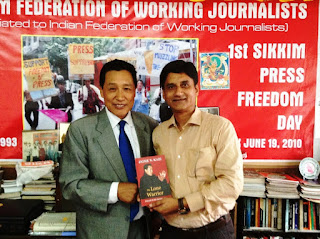A Thousand Years Struggle To Preserve “Sikkim For Sikkimese”
The time has come for the Sikkimese people,
irrespective of caste, creed and community, to stand up for their rights,
assert themselves, and be heard. We have for long placed much hope on the
political leadership in the State to come to their senses and build a strong,
stable, peaceful, prosperous and united Sikkim, which is not only in the
interest of Sikkimese people but also those who have been living in the State
in the past so many decades and for the country’s security interest in the
region.
It has now become more than clear that the
combined political leadership in the State has failed to live up to the
expectations of the people. The corrupt, communal, immoral and dictatorial
forces in the State in the past so many years and months have virtually turned
Sikkim into a den of thieves, a place where the Sikkimese people and others
living here have been forced to live in great humiliation and indignity. The Sikkimese people, comprising of the three
ethnic groups – Lepchas, Bhutias and Nepalese – instead of being masters of
their own destiny, have virtually become foreigners in their own homeland.
Pix: Courtesy - www.bayultour.com
The democratic movement of the people for
restoration of freedom, democracy and justice in the State of Sikkim has now
turned sour. Instead of forging ahead with clear vision and determination to
set things rights the political leadership from almost all political parties
are giving undue importance to petty matters. This is a clear indication that
the hopes and aspirations of the Sikkimese people have been sacrificed to
fulfill the greed, ambition and self-interest of a few individuals at the top.
Corrupt and communal forces, aided by an
evil nexus of bureaucrats, businessmen and politicians, who have in the past so
many years trampled over the rights and interests of the Sikkimese people, are
once again flexing their muscle and making their ugly presence felt in State
politics. They are determined to stay in power at whatever the cost. It is at
such times as these that we ought to remind ourselves of the need to place our
long-term interest before short-term gains and make a determined effort to “pay
any price, bear any burden, meet any hardship, support any friend, oppose any
foe, in order to assure the survival and success of liberty”, democracy and
justice.
Let us remind ourselves at this point of
time that the real issue in our State is a fight between those who wish to wipe
us out and remain perpetually in power at whatever the cost and those who have
for long suffered and endured the system that thrives on lies, deceit, and
corruption. The people in general today may be fooled into believing something
else but we believe and are convinced that the real issue and the real fight in
Sikkim today is not between this or that party or between this or that
community. The real issue and the real fight is between the rich and the poor,
between the haves and have-nots. A microscopic section of the elite, who have
usurped power and perfected the intricate art of corruption and communal
politics, are a class of their own, and do not belong to any particular
community. They want to remain at the top forever.
This is not possible. We cannot take this nonsense
any longer. It is time that the Sikkimese people from all communities and from
all walks of life and age assert themselves and take a firm and united stand
and say in a loud and unequivocal voice that “Enough is enough’. The need of
the hour is unity and solidarity amongst the Sikkimese people to preserve “Sikkim
By forming the Organisation of Sikkimse
Unity (OSU) we have declared a thousand years war against those who wish to
destroy the unity, identity and communal harmony of the Sikkimese people and
the nation’s security interest in the region. Other organizations and
individuals may involve themselves in petty matters and contest elections. We
who belong to the Organisation of Sikkimese Unity (OSU) will fight for the
basic rights and interests of the Sikkimese people no matter how long and hard
the battle is. We shall fight in the Assembly. We shall fight in the
Parliament. We shall fight in the Court and in the Press. If need be, we shall
fight in the fields and in the streets. Wherever we are, whatever we do, we
shall fight. We shall never surrender. Never.
----------------------------------
(Jigme N. Kazi, Chairman, Organisation of
Sikkimese Unity (OSU), issued this appeal to the public through this column, On
My Own, on October 24/29, 1994, prior to the Assembly elections in November,
1994. As the message was still relevant, the appeal was published again in
October, 1999, prior to the Assembly elections in Oct-Nov, 1999)
















.jpg)
.jpg)

